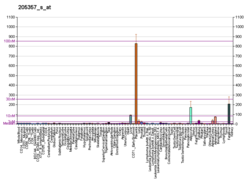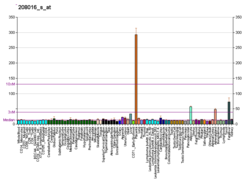
Summary
Angiotensin II receptor type 1 (AT1) is a Gq/11-coupled G protein-coupled receptor (GPCR) and the best characterized angiotensin receptor. It is encoded in humans by the AGTR1 gene. AT1 has vasopressor effects and regulates aldosterone secretion. It is an important effector controlling blood pressure and volume in the cardiovascular system. Angiotensin II receptor blockers are drugs indicated for hypertension, diabetic nephropathy and congestive heart failure.
| AGTR1 | |||||||||||||||||||||||||||||||||||||||||||||||||||
|---|---|---|---|---|---|---|---|---|---|---|---|---|---|---|---|---|---|---|---|---|---|---|---|---|---|---|---|---|---|---|---|---|---|---|---|---|---|---|---|---|---|---|---|---|---|---|---|---|---|---|---|
 | |||||||||||||||||||||||||||||||||||||||||||||||||||
| |||||||||||||||||||||||||||||||||||||||||||||||||||
| Identifiers | |||||||||||||||||||||||||||||||||||||||||||||||||||
| Aliases | AGTR1, AG2S, AGTR1B, AT1, AT1AR, AT1B, AT1BR, AT1R, AT2R1, HAT1R, angiotensin II receptor type 1 | ||||||||||||||||||||||||||||||||||||||||||||||||||
| External IDs | OMIM: 106165 MGI: 87964 HomoloGene: 3556 GeneCards: AGTR1 | ||||||||||||||||||||||||||||||||||||||||||||||||||
| |||||||||||||||||||||||||||||||||||||||||||||||||||
| |||||||||||||||||||||||||||||||||||||||||||||||||||
| |||||||||||||||||||||||||||||||||||||||||||||||||||
| |||||||||||||||||||||||||||||||||||||||||||||||||||
| |||||||||||||||||||||||||||||||||||||||||||||||||||
| Wikidata | |||||||||||||||||||||||||||||||||||||||||||||||||||
| |||||||||||||||||||||||||||||||||||||||||||||||||||
Signaling cascade edit
The angiotensin receptor is activated by the vasoconstricting peptide angiotensin II. The activated receptor in turn couples to Gq/11 and thus activates phospholipase C and increases the cytosolic Ca2+ concentrations, which in turn triggers cellular responses such as stimulation of protein kinase C. Activated receptor also inhibits adenylate cyclase in hepatocytes and activates various tyrosine kinases.[5]
Function edit
The AT1 receptor mediates the major cardiovascular effects of angiotensin II. Effects include vasoconstriction, aldosterone synthesis and secretion, increased vasopressin secretion, cardiac hypertrophy, augmentation of peripheral noradrenergic activity, vascular smooth muscle cells proliferation, decreased renal blood flow, renal renin inhibition, renal tubular sodium reuptake, modulation of central sympathetic nervous system activity, cardiac contractility, central osmocontrol and extracellular matrix formation.[6] The main function of angiotensin II in the brain is to stimulate drinking behavior, an effect that is mediated by the AT1 receptor.[7][8]
Clinical significance edit
Due to the hemodynamic pressure and volume effects mediated by AT1 receptors, AT1 receptor antagonists are widely prescribed drugs in the management of hypertension and stable heart failure.[9]
Animal studies edit
Elements of the renin-angiotensin system have been widely studied in a large variety of vertebrate animals including amphibians, reptiles, birds, and mammals.[10]
AT1 receptor blockers have been shown to reduce fear memory recall in mice, but the reliability and relevance of this finding are to be determined.[11][12]
Gene edit
It was previously thought that a related gene, denoted as AGTR1B, existed; however, it is now believed that there is only one type 1 receptor gene in humans. At least four transcript variants have been described for this gene. Additional variants have been described but their full-length nature has not been determined. The entire coding sequence is contained in the terminal exon and is present in all transcript variants.[13]
A huge number of polymorphisms is reported in the databases for AT1R which provide an avenue to explore these polymorphisms for their implications in protein structure, function and drug efficacy. Methods In the current study all the SNPs (10234) reported in NCBI were analyzed and SNPs which were important in protein structure and drug interactions were identified. Structures of these polymorphic forms were modeled and in silico drug interaction studies were carried out. Results Result of the interaction studies with polymorphism was in correlation with the reported case. Two SNP mutated structures of AT1R i.e. rs780860717 (G288T), rs868647200 (A182C) shows considerably less binding affinities in case of all angiotensin receptor blockers (ARBs).[14]
Interactions edit
Angiotensin II receptor type 1 has been shown to interact with Zinc finger and BTB domain-containing protein 16.[15] The protein's mRNA has been reported to interact with Mir-132 microRNA as part of an RNA silencing mechanism that reduces receptor expression.[16]
References edit
- ^ a b c GRCh38: Ensembl release 89: ENSG00000144891 – Ensembl, May 2017
- ^ a b c GRCm38: Ensembl release 89: ENSMUSG00000049115 – Ensembl, May 2017
- ^ "Human PubMed Reference:". National Center for Biotechnology Information, U.S. National Library of Medicine.
- ^ "Mouse PubMed Reference:". National Center for Biotechnology Information, U.S. National Library of Medicine.
- ^ Higuchi S, Ohtsu H, Suzuki H, Shirai H, Frank GD, Eguchi S (April 2007). "Angiotensin II signal transduction through the AT1 receptor: novel insights into mechanisms and pathophysiology". Clinical Science. 112 (8): 417–428. doi:10.1042/CS20060342. PMID 17346243. S2CID 27624282.
- ^ Catt KJ, Mendelsohn FA, Millan MA, Aguilera G (1984). "The role of angiotensin II receptors in vascular regulation". Journal of Cardiovascular Pharmacology. 6 (Suppl 4): S575–S586. doi:10.1097/00005344-198406004-00004. PMID 6083400.
- ^ Barbella Y, Cierco M, Israel A (April 1993). "Effect of Losartan, a nonpeptide angiotensin II receptor antagonist, on drinking behavior and renal actions of centrally administered renin". Proceedings of the Society for Experimental Biology and Medicine. 202 (4): 401–406. doi:10.3181/00379727-202-43551. PMID 8456103. S2CID 38235497.
- ^ Malvin RL, Mouw D, Vander AJ (July 1977). "Angiotensin: physiological role in water-deprivation-induced thirst of rats". Science. 197 (4299): 171–173. Bibcode:1977Sci...197..171M. doi:10.1126/science.877549. PMID 877549.
- ^ "Angiotensin II receptor blocker", Wikipedia, 2022-07-26, retrieved 2022-08-10
- ^ Wilson JX (1984). "The renin-angiotensin system in nonmammalian vertebrates". Endocrine Reviews. 5 (1): 45–61. doi:10.1210/edrv-5-1-45. PMID 6368215.
- ^ Marvar PJ, Goodman J, Fuchs S, Choi DC, Banerjee S, Ressler KJ (June 2014). "Angiotensin type 1 receptor inhibition enhances the extinction of fear memory". Biological Psychiatry. 75 (11): 864–872. doi:10.1016/j.biopsych.2013.08.024. PMC 3975818. PMID 24094510.
- ^ Hurt RC, Garrett JC, Keifer OP, Linares A, Couling L, Speth RC, et al. (September 2015). "Angiotensin type 1a receptors on corticotropin-releasing factor neurons contribute to the expression of conditioned fear". Genes, Brain and Behavior. 14 (7): 526–533. doi:10.1111/gbb.12235. PMC 4573765. PMID 26257395.
- ^ "Entrez Gene: AGTR1 angiotensin II receptor, type 1".
- ^ Sharma B, Jaiswal V, Khan MA (October 2020). "In silico Approach for Exploring the Role of AT1R Polymorphism on its Function, Structure and Drug Interactions". Current Computer-Aided Drug Design. 17 (7): 927–935. doi:10.2174/1573409916666201023113709. PMID 33100208. S2CID 225071659.
- ^ Senbonmatsu T, Saito T, Landon EJ, Watanabe O, Price E, Roberts RL, et al. (December 2003). "A novel angiotensin II type 2 receptor signaling pathway: possible role in cardiac hypertrophy". The EMBO Journal. 22 (24): 6471–6482. doi:10.1093/emboj/cdg637. PMC 291832. PMID 14657020.
- ^ Elton TS, Kuhn DE, Malana GE, Martin MM, Nuovo GJ, Pleister AP, Feldman DS (2007). "MiR-132 Regulates Angiotensin II Type 1 Receptor Expression Through a Protein Coding Region Binding Site". Circulation. 118 (18): S513.
- This article incorporates text from the United States National Library of Medicine, which is in the public domain.
Further reading edit
- Matsusaka T, Ichikawa I (1997). "Biological functions of angiotensin and its receptors". Annual Review of Physiology. 59: 395–412. doi:10.1146/annurev.physiol.59.1.395. PMID 9074770.
- Allen AM, Moeller I, Jenkins TA, Zhuo J, Aldred GP, Chai SY, Mendelsohn FA (September 1998). "Angiotensin receptors in the nervous system". Brain Research Bulletin. 47 (1): 17–28. doi:10.1016/S0361-9230(98)00039-2. PMID 9766385. S2CID 24936475.
- Berry C, Touyz R, Dominiczak AF, Webb RC, Johns DG (December 2001). "Angiotensin receptors: signaling, vascular pathophysiology, and interactions with ceramide". American Journal of Physiology. Heart and Circulatory Physiology. 281 (6): H2337–H2365. doi:10.1152/ajpheart.2001.281.6.H2337. PMID 11709400. S2CID 41296327.
- Arima S, Ito S (November 2001). "New insights into actions of the renin-angiotensin system in the kidney: concentrating on the Ang II receptors and the newly described Ang-(1-7) and its receptor". Seminars in Nephrology. 21 (6): 535–543. doi:10.1053/snep.2001.26792. PMID 11709801.
- Stowasser M, Gunasekera TG, Gordon RD (December 2001). "Familial varieties of primary aldosteronism". Clinical and Experimental Pharmacology & Physiology. 28 (12): 1087–1090. doi:10.1046/j.1440-1681.2001.03574.x. PMID 11903322. S2CID 23091842.
- Padmanabhan N, Padmanabhan S, Connell JM (December 2000). "Genetic basis of cardiovascular disease--the renin-angiotensin-aldosterone system as a paradigm". Journal of the Renin-Angiotensin-Aldosterone System. 1 (4): 316–324. doi:10.3317/jraas.2000.060. PMID 11967817.
- Thibonnier M, Coles P, Thibonnier A, Shoham M (2002). "Chapter 14 Molecular pharmacology and modeling of vasopressin receptors". Vasopressin and Oxytocin: From Genes to Clinical Applications. Progress in Brain Research. Vol. 139. pp. 179–96. doi:10.1016/S0079-6123(02)39016-2. ISBN 978-0-444-50982-6. PMID 12436935.
- Elton TS, Martin MM (March 2003). "Alternative splicing: a novel mechanism to fine-tune the expression and function of the human AT1 receptor". Trends in Endocrinology and Metabolism. 14 (2): 66–71. doi:10.1016/S1043-2760(02)00038-3. PMID 12591176. S2CID 45146964.
- Saavedra JM, Benicky J, Zhou J (2007). "Mechanisms of the Anti-Ischemic Effect of Angiotensin II AT( 1 ) Receptor Antagonists in the Brain". Cellular and Molecular Neurobiology. 26 (7–8): 1099–1111. doi:10.1007/s10571-006-9009-0. PMID 16636899. S2CID 20245643.
- Oliveira L, Costa-Neto CM, Nakaie CR, Schreier S, Shimuta SI, Paiva AC (April 2007). "The angiotensin II AT1 receptor structure-activity correlations in the light of rhodopsin structure". Physiological Reviews. 87 (2): 565–592. doi:10.1152/physrev.00040.2005. PMID 17429042.
- Ariza AC, Bobadilla NA, Halhali A (2007). "[Endothelin 1 and angiotensin II in preeeclampsia]". Revista de Investigacion Clinica. 59 (1): 48–56. PMID 17569300.
- Xia Y, Zhou CC, Ramin SM, Kellems RE (September 2007). "Angiotensin receptors, autoimmunity, and preeclampsia". Journal of Immunology. 179 (6): 3391–3395. doi:10.4049/jimmunol.179.6.3391. PMC 3262172. PMID 17785770.
- Mauzy CA, Hwang O, Egloff AM, Wu LH, Chung FZ (July 1992). "Cloning, expression, and characterization of a gene encoding the human angiotensin II type 1A receptor". Biochemical and Biophysical Research Communications. 186 (1): 277–284. doi:10.1016/S0006-291X(05)80804-6. PMID 1378723.
- Curnow KM, Pascoe L, White PC (July 1992). "Genetic analysis of the human type-1 angiotensin II receptor". Molecular Endocrinology. 6 (7): 1113–1118. doi:10.1210/mend.6.7.1508224. PMID 1508224.
- Furuta H, Guo DF, Inagami T (February 1992). "Molecular cloning and sequencing of the gene encoding human angiotensin II type 1 receptor". Biochemical and Biophysical Research Communications. 183 (1): 8–13. doi:10.1016/0006-291X(92)91600-U. PMID 1543512.
- Takayanagi R, Ohnaka K, Sakai Y, Nakao R, Yanase T, Haji M, et al. (March 1992). "Molecular cloning, sequence analysis and expression of a cDNA encoding human type-1 angiotensin II receptor". Biochemical and Biophysical Research Communications. 183 (2): 910–916. doi:10.1016/0006-291X(92)90570-B. PMID 1550596.
- Bergsma DJ, Ellis C, Kumar C, Nuthulaganti P, Kersten H, Elshourbagy N, et al. (March 1992). "Cloning and characterization of a human angiotensin II type 1 receptor". Biochemical and Biophysical Research Communications. 183 (3): 989–995. doi:10.1016/S0006-291X(05)80288-8. PMID 1567413. S2CID 19816702.
- Gemmill RM, Drabkin HA (1992). "Report of the Second International Workshop on Human Chromosome 3 mapping". Cytogenetics and Cell Genetics. 57 (4): 162–166. doi:10.1159/000133138. PMID 1683828.
- Curnow KM, Pascoe L, Davies E, White PC, Corvol P, Clauser E (September 1995). "Alternatively spliced human type 1 angiotensin II receptor mRNAs are translated at different efficiencies and encode two receptor isoforms". Molecular Endocrinology. 9 (9): 1250–1262. doi:10.1210/mend.9.9.7491117. PMID 7491117. S2CID 46112700.
- Marrero MB, Schieffer B, Paxton WG, Heerdt L, Berk BC, Delafontaine P, Bernstein KE (May 1995). "Direct stimulation of Jak/STAT pathway by the angiotensin II AT1 receptor". Nature. 375 (6528): 247–250. Bibcode:1995Natur.375..247M. doi:10.1038/375247a0. PMID 7746328. S2CID 4272223.
External links edit
- "Angiotensin Receptors: AT1". IUPHAR Database of Receptors and Ion Channels. International Union of Basic and Clinical Pharmacology. Archived from the original on 2014-02-28. Retrieved 2008-11-25.
- Human AGTR1 genome location and AGTR1 gene details page in the UCSC Genome Browser.








